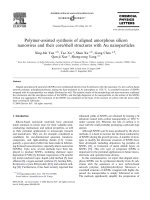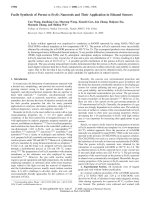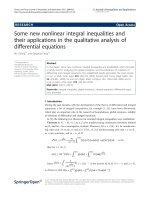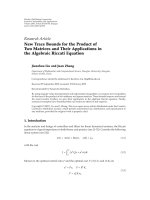Facile synthesis of combinatorial vinyl sulfone libraries and their applications in large scale proteomics
Bạn đang xem bản rút gọn của tài liệu. Xem và tải ngay bản đầy đủ của tài liệu tại đây (2.34 MB, 123 trang )
FACILE SYNTHESIS OF COMBINATORIAL VINYL
SULFONE LIBRARIES AND THEIR APPLICATIONS IN
LARGE SCALE PROTEOMICS
WANG GANG
NATIONAL UNIVERSITY OF SINGAPORE
2004
FACILE SYNTHESIS OF COMBINATORIAL VINYL
SULFONE LIBRARIES AND THEIR APPLICATIONS IN
LARGE SCALE PROTEOMICS
WANG GANG
A THESIS SUBMITTED
FOR THE DEGREE OF MASTER OF SCIENCE
DEPARTMENT OF CHEMISTRY
NATIONAL UNIVERSITY OF SINGAPORE
2004
ACKNOWLEDGEMENTS
I would like to express my greatest gratitude to my supervisor Assistant Professor
Yao Shao Qin for his patient guidance, stimulating ideas and invaluable advice
throughout my study. I benefited a lot from his instructions and demonstrations.
I would also like to express my appreciation to my group members, Dr. Zhu Qing, Dr
Li Dongbo, Elaine Chan, Ming-Lee Liau, Resmi and Rajavel from the chemistry lab, Y. J.
Chen, Grace, Hu Yi and other people from the DBS lab, for their help and encouragement
during my research.
I appreciate the support of the research laboratory staff Mdm Han Yanhui and Ms
Peggy Ler from the NMR laboratory, Mdm Wong Lai Kwan and Mdm Lai Hui Ngee
from the MS lab. I can always receive help from them when I was facing technical
problems.
I am also grateful to the National University of Singapore, for providing me research
scholarship.
i
TABLE OF CONTENTS
ACKNOWLEDGEMENTS
i
TABLE OF CONTENTS
ii
SUMMARY
vii
LIST OF TABLES
ix
LIST OF FIGURES
x
LIST OF SCHEMES
xii
ABBREVIATIONS
xiii
PUBLICATIONS
xvii
Chapter 1 Introduction
1
1.1
Proteomics
1
1.2
Activity-based proteomics
1
1.3
Activity-based probes
3
1.4
Cysteine proteases and viny sulfone compounds
6
1.5
Positional Scanning Library
9
1.6
Aim of our project
11
Chapter 2 Solution phase synthesis of a vinyl sulfone probe
12
2.1
Introduction
12
2.2
Results and discussion
13
2.2.1
Synthesis of H2N-Tyr(tBu)-vinyl sulfone
14
2.2.2
Synthesis of Cy3-Gly-Leu-Leu-OH
15
ii
2.2.3
Synthesis of Cy3-Gly-Leu-Leu-Tyr-vinyl sulfone
2.2.4 Application of the Cy3-Gly-Leu-Leu-Tyr-vinyl sulfone
16
17
probe in enzyme profiling
2.3
Conclusion
18
Chapter 3 Solid-phase synthesis of peptide vinyl sulfone probes 20
3.1
Introduction
20
3.2
Results and discussion
22
3.2.1 Solid-phase synthesis of peptide vinyl sulfone probe
22
via 2-Cl-Trityl-Chloride resin
3.2.1.1 Synthesis and immobilization of 14 onto 2-Cl-Trityl resin
23
3.2.1.2 Synthesis of vinyl sulfone probe Cy3-GLLY-VS on
25
2-Cl-Trityl resin
3.2.1.3 SDS-PAGE results for Cy3-GLLY-VS probe 18
26
3.2.2 Solid-phase synthesis of peptide vinyl sulfone probes via
27
Rink-amide resin
3.2.2.1 Synthesis of peptide vinyl sulfone H2N-CLFL-VS
28
3.2.2.2 Combinatorial synthesis of vinyl sulfone probes with
30
P1 variation
3.2.2.3 Labelling papain with 20 vinyl sulfone probes
33
3.3
34
Conclusion
Chapter 4 Combinatorial synthesis of vinyl sulfone small molecules
36
iii
4.1
Introduction
36
4.2
Results and discussion
38
4.2.1
Overall scheme
38
4.2.2 Synthesis of Rink resin bound sulfide phosphonate 31
39
4.2.3 Synthesis of Rink resin bound sulfone phosphonate 32
40
4.2.4 Solid-phase Horner-Wadsworth-Emmons reaction
40
4.2.5 Determination of the racemization of solid-phase
42
Horner-Wadsworth-Emmons reaction products
4.2.6
Synthesis of a 30-member vinyl sulfone small molecule library
44
4.3
Conclusion
48
Chapter 5 Experimental
50
5.1
General information
50
5.2
Experimental procedures
50
5.2.1
Solution phase synthesis of vinyl sulfone probe
50
5.2.2 Solid-phase synthesis of peptide vinyl sulfone probe via
57
Trityl-chloride resin
5.2.3
Determination of resin loading efficiency by Fmoc analysis 51
5.2.4. Activity based protein labeling in SDS-PAGE experiments
59
using probe 18
5.2.5 Combinatorial synthesis of peptide vinyl sulfone probe
59
via Rink-amide resin
5.2.6
SDS-PAGE experiments with combinatorial vinyl sulfone
66
iv
probes and papain
5.2.7
Synthesis of vinyl sulfone small molecule library
66
5.2.8
Qualitative ninhydrin test
77
Chapter 6 References
78
Chapter 7 Appendices
87
7.1
Fmoc-Tyr(tBu)-H (4)
87
7.2
Fmoc-Tyr(tBu)-vinyl sulfone (5)
88
7.3
H2N-Tyr(tBu)-vinyl sulfone (6)
89
7.4
Cy3-Gly-Leu-Leu-OH (10)
90
7.5
ESI-MS for Cy3-GLLY-VS (12)
91
7.6
4-Hydroxy-thiophenyl-methyl-diethylphosphonate sulfone (13)
92
7.7
Fmoc-Asp(tBu)-vinyl sulfone (14a)
93
7.8
Fmoc-Leu-vinyl sulfone (14b)
94
7.9
Fmoc-Lys(Boc)-vinyl sulfone (14c)
96
7.10
Fmoc-Phe-vinyl sulfone (14d)
98
7.11
Fmoc-Tyr(tBu)-vinyl sulfone (14e)
99
7.11
Fmoc-Asn(Trt)-H (21b)
100
7.12
Fmoc-Asp(tBu)-H(21c)
102
7.13
Fmoc-Cys(Trt)-H (21d)
103
7.14
Fmoc-Gln(Trt)-H (21e)
105
7.15
Fmoc-Glu(tBu)-H (21f)
107
v
7.16
Fmoc-His(Trt)-H (21h)
108
7.17
Fmoc-Ile-H (21i)
110
7.18
Fmoc-Leu-H (21j)
111
7.19
Fmoc-Lys(Boc)-H (21k)
113
7.20
Fmoc-Met-H (21l)
115
7.21
Fmoc-Phe-H (21m)
117
7.22
Fmoc-Ser(tBu)-H (21n)
119
7.23
Fmoc-Thr(tBu)-H (21o)
121
7.24
Fmoc-Trp(Boc)-H (21p)
123
7.25
Fmoc-Val-H (21r)
125
7.26
4-[(Diethoxyphosphoryl)-thiomethyl]-benzoic acid (30a)
126
7.27
11-[(Diethoxyphosphoryl)-thiomethyl]-undecanoic acid (30b)
127
7.28
2-[(Diethoxyphosphoryl)-thiomethyl]-nicotinic acid (30c)
128
7.29
Anisoyl-Leu-vinyl-sulfonyl-undecanamide (37.1)
129
7.30
Isonicotinoyl-Leu-vinyl-sulfonyl-undecanamide (37.2)
130
7.31
Isonicotinoyl-Asp-vinyl-sulfonyl-undecanamide (37.4)
131
7.32
Isonicotinoyl-Tyr-vinyl-sulfonyl-undecanamide (37.6)
133
7.33
Anisoyl-Lys-vinyl-sulfonyl-undecanamide (37.9)
134
7.34
Isonicotinoyl-Leu-vinyl-sulfonyl-benzamide (37.12)
136
7.35
Isonicotinoyl-Asp-vinyl-sulfonyl-benzamide (37.14)
138
vi
SUMMARY
Activity-based proteomics plays an important role in profiling those proteins with
enzymatic activities. The design and synthesis of chemical probes for enzymes are
essential to the success of this strategy. Vinyl sulfone compounds have been shown to be
extremely useful as activity-based inhibitors or probes for cysteine proteases. We aim to
expand the application of vinyl sulfone compounds in large scale proteomics by
designing new synthetic strategies and applying them to the generation of libraries of
vinyl sulfone probes and small molecule inhibitors.
In Chapter 2, we synthesized a fluorescent-tagged probe Cy3-GLLY-VS based on a
solution phase synthesis strategy. This probe was proved to be effective in selectively
labeling cysteine protease in the presence of other proteases in a microarray experiment.
The synthesis, although successful, is very inefficient. Thus, we designed new solidphase strategies to synthesize vinyl sulfone probes. As shown in Chapter 3, our first
solid-phase strategy was based on the synthesis and immobilization of phenolic-Fmocamino-vinyl sulfones onto 2-Cl-Trityl chloride resin, followed by peptide synthesis and
probe generation. This strategy was successful as five different phenolic-Fmoc-aminovinyl sulfones were immobilized onto 2-Cl-Trityl chloride resin with high loading
efficiency, and one vinyl sulfone probe was successful synthesized and tested in a Gelbased experiment. Our second strategy was more suitable for the generation of positional
scanning library of vinyl sulfone probes with P1 variation. By taking advantage of the
successful implementation of both solid phase oxidation and Horner-Wadsworth-
vii
Emmons reaction, we successfully synthesized a library of vinyl sulfone probes.
Preliminary test with papain showed the probes were effective in enzyme profiling.
In Chapter 4, we discussed the successful synthesis of a 30-member vinyl sulfone
small molecule library. Three points of diversity (P1, P2 and P1′) within the vinyl sulfone
scaffold were introduced. Potentially large libraries of vinyl sulfone small molecules
could be synthesized this way and used to identify specific small molecule inhibitors for
disease related cysteine protease.
In Chapter 5, all the details of the experiments as well as the characterization of
products by NMR and MS are described.
Selected NMR and MS spectra and listed in the Appendices.
viii
LIST OF TABLES
Table 1
Components of activity-based probes
5
Table 2
Yield of 14, and the loading efficiency on 2-Cl-Trityl
23
-Chloride resin.
Table 3
Yield of Fmoc-AA-H
31
Table 4
ESI-MS data for 20 vinyl sulfone probes with P1 variation
32
Table 5
Horner-Wadsworth-Emmons reaction from 32a to 33a
42
under different conditions
Table 6
ESI-MS and HPLC data of vinyl sulfone small molecules
46
ix
LIST OF FIGURES
Figure 1
General structure of an activity-based probe
3
Figure 2
Strategy for activity-based protein profiling
5
Figure 3a
Interaction between substrate and enzyme active site
8
Figure 3b
Interaction between peptide vinyl sulfone and enzyme active site. 8
Figure 3c
Mechanism of peptide vinyl sulfone inhibiting cysteine protease
8
Figure 4
Positional scanning library in the generation of affinity
10
fingerprint of peptide epoxide inhibitors
Figure 5
Synthesis of Boc-Leu-vinyl sulfone
12
Figure 6
Synthesis of vinyl sulfonate esters and vinyl sulfonamides
13
Figure 7
Structure of the Cy3-Gly-Leu-Leu-Tyr-VS proble
14
Figure 8
Activity-based protein profiling using probe 12 in a
18
microarray-based experiment
Figure 9
Solid-phase synthesis of vinyl sulfone compound via
20
safety catch resin
Figure 10
Solid-phase synthesis of vinyl sulfone compounds via
21
Rink amide resin and the side chain of aspartic acid
Figure 11
Immobilization of 14 onto Wang resin under Mitsunobu
23
reaction condition
Figure 12
Immobilization of phenolic alcohol onto trichloroacetimidate
25
activated Wang resin
x
Figure 13
Activity-based protein profiling using probe 7
27
Figure 14
HPLC spectrum of peptide vinyl sulfone H2N-CLFL-VS
29
Figure 15
Intramolecular cyclization of Fmoc-Arg(pbf)-CHO
30
Figure 16
SDS-PAGE result for labelling papain with 20 vinyl
34
sulfone probes
Figure 17
APC-3328, a potential lead compound for osteoporosis
37
Figure 18
A vinyl sulfone small molecule binding to the active site
38
of a cysteine protease.
Figure 19
HPLC spectra for diastereomeric and enantiomeric dipeptides
44
vinyl sulfones
Figure 20
Piperidine adduct of vinyl sulfone small molecule
45
xi
LIST OF SCHEMES
Scheme 1
Synthesis of H2N-Tyr(tBu)-vinyl sulfone
15
Scheme 2
Synthesis of Cy3-Gly-Leu-Leu-OH
16
Scheme 3
Synthesis of Cy3-Gly-Leu-Leu-Tyr-vinyl sulfone
17
Scheme 4
Solid-phase synthesis of vinyl sulfone probes via
22
2-Cl-Trityl -chloride resin
Scheme 5
Solid-phase synthesis of Cy3-GLLY-VS probe via
26
2-Cl-Trityl -chloride resin
Scheme 6
Solid-phase synthesis of vinyl sulfone compounds via
28
Rink amide resin
Scheme 7
Synthesis of peptide vinyl sulfone H2N-CLFL-VS
29
Scheme 8
Combinatorial synthesis of vinyl sulfone probes with
32
P1 variation
Scheme 9
Synthesis of a 30-member vinyl sulfone small molecule library
39
Scheme 10
Generation of diastereomeric and enantiomeric dipeptide
43
vinyl sulfones
xii
ABBREVIATIONS
AA
Amino acid
BF3.Et2O
Boron trifluoride ether complex
Boc
t-Butoxycarbonyl
br
Broad
Bu4NI
Tetrabutylammonium iodide
tBu
tert-Butyl
Cy3
Cyanine dye3
δ
Chemical shift
Da
Dalton
DBU
1,8-Diazobicyclo[5.4.0]undec-7-ene
DCC
N,N’-Dicyclohexylcarbodiimide
DCM
Dichloromethane
dd
Doublet of doublet
DEAD
Diethyl azodicarboxylate
DIC
N,N’-diisopropylcarbodiimide
DIEA
N,N’-diisopropylethylamine
DMAP
4-Dimethylaminopyridine
DMF
Dimethylformamide
DMSO
Dimethylsulfoxide
DTT
Dithiothreitol
EA
Ethyl acetate
xiii
EDC
1-Ethyl-3-(3-dimethylaminopropyl)carbodiimide HCl
EDTA
Ethylenediaminetetracetic acid
ESI
Electron Spray Ionization
Et
Ethyl
Fmoc
9-Fluorenylmethoxycarbonyl
HATU
O-(7-azabenzotrizol-1-yl)-1,1,3,3,tetramethyluronium
hexafluorophosphate
HOBT
N-Hydroxybenzotriazole
HPLC
High Performance Liquid Chromatography
Hz
Hertz
KHMDS
Potassium bis(trimethylsilyl)amide
LAH
Lithium aluminum hydride
LDA
Lithium diisopropyl amide
LHMDS
Lithium bis(trimethylsilyl)amide
m
Multiplet
m-CPBA
m-Chloroperbenzoic acid
MS
Mass spectrometry
NaH
Sodium hydride
NHS
N-Hydroxysuccinimide
NMR
N-Methylpyrrolidinone
PPh3
Triphenylphosphine
q
Quartet
r.t.
Room temperature
xiv
s
Singlet
SDS-PAGE
Sodium dodecyl sulfate-polyacrylamide gel electrophoresis
t
Triplet
TBTU
O-(Benzotriazol-1-yl)-N,N,N’,N’-tetramethyluronium
tetraborofluorate
TFA
Trifluoroacetic acid
THF
Tetrahydrofuran
TLC
Thin layer chromatography
Tris
Trishydroxymethylamino methane
uv
Ultraviolet
VS
Vinyl sulfone
Z
Benzyloxycarbonyl or Cbz
xv
ABBREVIATIONS FOR AMINO ACIDS
Name
Alanine
Abbr.
ala a
Linear structure formula
CH3-CH(NH2)-COOH
Arginine
arg r
HN=C(NH2)-NH-(CH2)3-CH(NH2)-COOH
Asparagine
asn n
H2N-CO-CH2-CH(NH2)-COOH
Aspartic acid
asp d
HOOC-CH2-CH(NH2)-COOH
Cysteine
cys c
HS-CH2-CH(NH2)-COOH
Glutamine
gln q
H2N-CO-(CH2)2-CH(NH2)-COOH
Glutamic acid
glu e
HOOC-(CH2)2-CH(NH2)-COOH
Glycine
gly g
NH2-CH2-COOH
Histidine
his h
Isoleucine
ile i
NH-CH=N-CH=C-CH2-CH(NH2)-COOH
|__________|
CH3-CH2-CH(CH3)-CH(NH2)-COOH
Leucine
leu l
(CH3)2-CH-CH2-CH(NH2)-COOH
Lysine
lys k
H2N-(CH2)4-CH(NH2)-COOH
Methionine
met m
CH3-S-(CH2)2-CH(NH2)-COOH
Phenylalanine
phe f
Ph-CH2-CH(NH2)-COOH
Proline
pro p
Serine
ser s
NH-(CH2)3-CH-COOH
|_________|
HO-CH2-CH(NH2)-COOH
Threonine
thr t
CH3-CH(OH)-CH(NH2)-COOH
Tryptophan
trp w
Tyrosine
tyr y
Ph-NH-CH=C-CH2-CH(NH2)-COOH
|_______|
HO-p-Ph-CH2-CH(NH2)-COOH
Valine
val v
(CH3)2-CH-CH(NH2)-COOH
xvi
PUBLICATIONS
Wang, G., Yao, S.Q. “Combinatorial synthesis of a small-molecule library based on the
vinyl sulfone scaffold”, Org. Lett. 2003; 5(23); 4437-4440
Wang, G., Uttamchandani, M., Chen, Y.J.G, Yao, S.Q. “Solid-phase synthesis of peptide
vinyl sulfones as potential inhibitors and activity-based probes of cysteine proteases”,
Org. Lett. 2003; 5(5); 737-740
Hu, Y.; Wang, G., Chen, G.Y.J., Fu, X.; Yao, S.Q. “Proteome analysis of
Saccharomyces Cerevisiae under metal stress by 2-D differential gel electrophoresis
(DIGE)”, Electrophoresis 2003, 24(9), 1458-1470.
Chen, G.Y.J., Uttamchandani, M., Zhu, Q., Wang, G., Yao, S.Q. “Developing a novel
strategy for detection of enzymatic activities on a protein array”, Chembiochem, 2003;
No 4, 336-339.
xvii
Chapter 1 Introduction
1.1 Proteomics
Proteomics aims to study the function of all expressed proteins in a given organism
through the global analysis of protein expression and protein function.1 The correlation of
proteins with certain cellular functions or diseases can bring enormous benefits in
medicine and human health.2 With the accomplishment of the Human Genome Project
(HGP) that provides the “blueprint” of gene products, the opportunity of enquiring into
protein properties and activities in cellular context has been created.3
To accelerate the proteomic study, different methods and technologies have been
applied and developed.4 Gel-based proteomics,5, 6 mass spectrometry-based proteomics,7
array-based proteomics8,
9
et al. are the most important approaches. These strategies
enable the global quantification of protein expression and/or the global characterizations
of protein activities at variable degree of efficiency and fidelity.3
1.2 Activity-based Proteomics
Our strategy for the functional analysis of proteins is based on the activity-based
protein profiling. Conventional proteomics strategy for the separation, quantification, and
identification of proteins relies heavily on two-dimensional gel electrophoresis coupled
with protein staining and mass-spectrometry analysis (2DE-MS).10 This method suffers
from an inherent lack of resolving power of two-dimensional gel electrophoresis, several
important classes of proteins, including membrane-associated and low-abundance
proteins, are difficult to be analyzed by this technique.10 Recent proteomics approach
1
using isotope-coded affinity tag combined with mass spectrometry has enhanced the
sensitivity and accuracy in measuring protein expression level,11 but all these methods
have some intrinsic drawbacks since they use the relative abundance of proteins to
directly correlat with cellular function, which is a potential risk in proteomics studies.
Activity-based proteomics provides a complementary chemical approach to profile
dynamics in protein activities in complex proteomes.12 By a combination of techniques
such as two-dimensional gel electrophoresis, mass spectrometry and microarray, we are
able to use chemically reactive probes to profile and identify proteins in a proteome
complex by virtue of their activities.13, 14 These chemical probes can be designed to react
with proteins sharing a similar enzymatic activity, or to target a wide range of proteins
which are mechanically distinct. Currently most chemical probes are designed to target
specific classes of enzymes, such as serine hydrolases,15,
16
cysteine proteases,17-19
phosphotases,20 kinases et al..21 These enzymes play critical roles in modulating a variety
of biological processes,22-24 they function through the fine control of their catalytic
activities. Numerous post-translational events, protein–protein and protein–smallmolecule interactions can regulate enzyme activities.25 Activity-based proteomics may
reveal more insights into how enzymes function in a particular biological event by
studying enzyme activities directly, which are more closely related to their cellular
functions.26,
27
An example of activity-based proteomics is shown in the profiling of
protein tyrosine phosphatases (PTPs) in the whole proteome using PTPs specific
chemical probes.28 PTPs are involved in the regulation of many aspects of cellular
activity including proliferation, metabolism, migration, and survival. Except for the large
number and complexity of PTPs in cell signaling, the activities of many PTPs are tightly
2
regulated by post-translational mechanisms, which restrict the use of standard genomics
and proteomics methods for functional characterization of these enzymes. To facilitate
the functional analysis of PTPs, two activity-based probes that consist of
bromobenzylphosphonate as a PTP-specific trapping device were synthesized. These
probes are active site-directed irreversible inhibitors of PTPs, and they are extremely
specific toward PTPs while remaining inert to other proteins. These probes can be used to
profile PTPs on the basis of changes in their activity and could consequently facilitate the
profiling of PTPs activities in complex proteomes and the elucidation of PTPs cellular
function.
To broaden the scope and impact of activity-based proteomics, one crucial element
is the design and use of activity-based chemical probes for diverse enzymes or proteins.
Activity-based probes usually react with active enzymes or proteins through a covalent
bond.29 The successful generation of proteomics-compatible probes for additional enzyme
and protein classes will probably require the synthesis of more structurally diverse
libraries of candidate probes.12
1.3 Activity-based probes
The general structure of an activity-based probe is shown in Figure 1, which consists
of three units: a reactive unit, a linker unit and a tag unit.30
Tag Unit
Linker Unit
Reactive Unit
Figure 1 General structure of an activity-based probe
The reactive unit is a chemical reactivity that recognizes the enzyme active site and
covalently modifies it. Reactive units are mostly derived from enzyme inhibitors, they are
3
usually electrophilic chemical groups since most enzymes contain nucleophilic groups
within their active site.31 As shown in Table 1, activity-based probes with vinyl sulfone32
or epoxide19 as reactive unit can selectively target cysteine proteases, while sulfonate
ester-containing probes can target different classes of enzymes such as thiolases,
aldehyde dehydrogenases, epoxide hydrolase.14 This class of probes are called activitybased probes because they only target active enzymes which utilize enzyme catalytic
mechanism. If the reactive unit modifies the enzyme through an affinity interaction, the
probe is called an affinity-based probe.29 By incorporating these key scaffolds into our
probes, we can generate diverse probes which could target different classes of enzymes.
The linker unit is a bridge between the reactive unit and the tag unit. It could be a
peptide fragment, an alkyl chain or others. Peptide fragments are often used to improve
the selectivity and potency of the probe toward certain class of enzymes.33
The tag unit is used to facilitate the detection of proteins upon labeling by the probe.
A biotin tag enables the detection of labeled proteins through its antibody, as well as the
purification of the labeled protein via streptavidin-agarose beads.16 A fluorescent tag such
as Cy3 dye can offer a much higher sensitivity than the biotin tag, using this kind of tags,
quantitative assessment of separated proteins and potential high-throughput applications
become possible.26
4
Table 1 Components of activity-based probes
Tag Unit
Linker Unit
O
HN
O
H
N
NH
R1
R2
N
H
Reactive Unit
H
N
O
R3
Peptide fragment
S
Biotin tag
O
Epoxide
O
N
N
COOH
O
O
O
S
O
Alkyl linker
Vinyl sulfone
I
Cy3 Fluorescent tag
I125
O
O
HO
O2N
O
O
Polyethene linker
O
O S
O
Sulfonate ester
Isotope tag
Figure 2 shows a general approach to activity-based enzyme profiling. In a complex
proteome containing different enzymes, the fluorescent activity-based probe will only
selectively label a particular class of active enzymes. The labeled enzymes can be
separated by SDS-PAGE and visualized by fluorescent imaging, which could be further
characterized by mass spectrometry.
Figure 2 Strategy for activity-based protein profiling
5
1.4 Cysteine proteases and viny sulfone compounds
Currently the proteins that we are interested in are cysteine proteases. Cysteine
proteases are an important class of enzymes involved in the hydrolysis of peptide amide
bonds. They play vital roles in numerous physiological processes such as arthritis,
osteoporosis, Alzheimer’s disease, cancer cell invasion, and apoptosis.34-36 According to
their tertiary structures, they are classified as the papain, calpain, cathepsin, caspase and
other families.37 The structural differences among the cysteine proteases are useful for the
design of specific inhibitors or probes.22
Over the last few decades, many research groups have developed chemical
approaches capable of generating diverse small-molecule inhibitors that target different
classes of cysteine proteases with various degrees of efficacy fidelity.37 Most of these
enzyme inhibitors are active site directed. According to the type of interaction between
inhibitors and enzymes, they are further divided into reversible and irreversible
inhibitors.22 Reversible inhibitors usually involve a non-covalent interaction between
enzyme and inhibitor, although there are some exceptions, such as peptide aldehydes,
which interact with enzymes through hydrolytically labile covalent bond
38
. Irreversible
inhibitors interact with enzymes through a tight covalent bond which are compatible with
proteomics techniques such as gel electrophoresis. By attaching fluorophore or biotin
molecule to the inhibitors, these molecules can be used to probe various proteases either
in vitro or in vivo.
Many irreversible inhibitors of cysteine proteases have been designed. These
inhibitors interact with the active thiol of cysteine protease through alkylating, acylating,
phosphonylating, or sulfonylating functional groups. 20 Inhibitors employing alkylating
6









